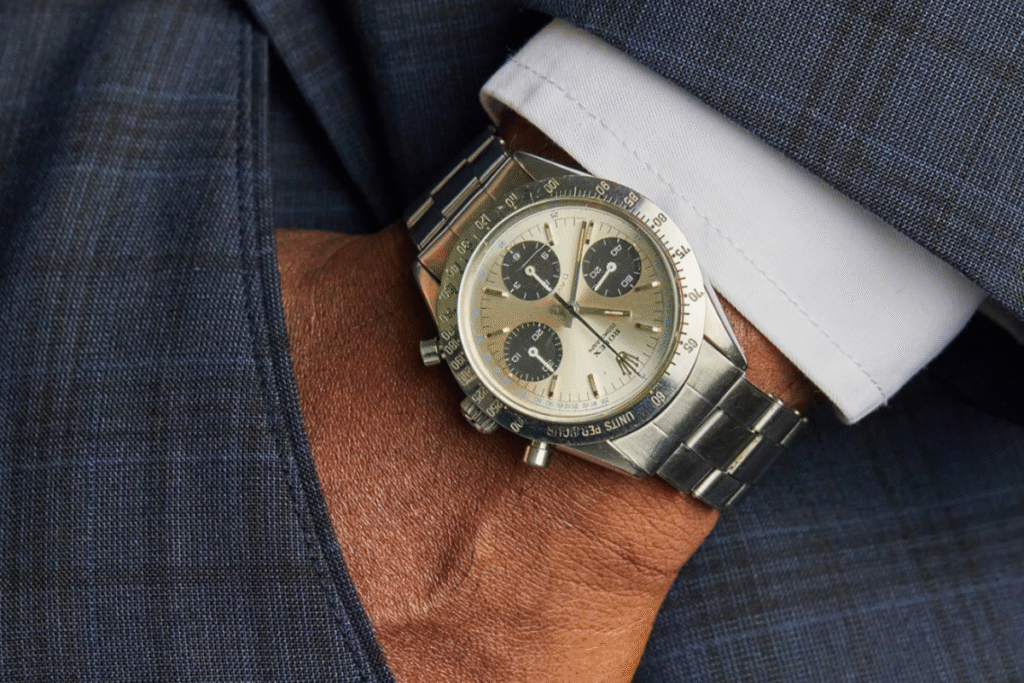Few watch complications embody both mechanical prowess and practical utility like the chronograph. Originally conceived as a scientific instrument rather than a luxury accessory, the chronograph’s core purpose was to measure elapsed time with precision, whether for racing, aviation, or medicine. Yet, beyond its stopwatch function, what makes the chronograph dial so fascinating are the specialized scales that transform it into a multi-purpose tool.
The most famous bezel is the tachymeter which measures speed over a fixed distance, then there is the telemeter calculates distance based on the speed of sound, for instance, the time between a lightning flash and thunder to calculate how far is a storm or the time between the flash and the roar of a cannon to measure how far is the enemy. And then there is the pulsometer, the most intimate of the three, was designed for doctors, allowing them to read a patient’s heart rate directly from the dial.
Each scale reflects a specific professional need and, today, tells a story about the era when wristwatches were precision instruments for specialists. Among them, the pulsometer stands out as both functional and rare, a feature that found its most celebrated expression in one of Rolex’s most elusive creations: the reference 6239 with a pulsometric scale.
What is a pulsometric scale and how was it used
The pulsometric scale (also called a pulsometer scale) is a graduated scale on a chronograph dial that enables the wearer to measure a person’s heart-rate by timing a fixed number of pulses rather than counting for a full minute. The principle: a chronograph function is started at the first heartbeat of a patient and stopped when a predetermined number of beats has been reached. At that moment the position of the chronograph seconds hand against the pulsometer scale reads off directly the beats per minute (BPM).

Historically, as watchmaking evolved in the early-to-mid 20th century, several chronograph watches incorporated this scale for use by medical professionals, doctors, nurses, or hospital staff needing a reliable wrist-worn instrument for measuring pulse rate.
Why use a pulsometer rather than just count for 60 seconds? Because by counting a smaller number of beats (e.g., 15 or 30) and using the calibrated scale, one gets a reasonably accurate reading in less time, useful in a clinical context. For example, a “Base 15” scale means you stop after 15 heartbeats and read the heart rate directly.

From an aesthetic and collecting standpoint, the presence of a pulsometer scale on a chronograph dial has become a desirable rarity: the dial layout needs to be modified (hour markers moved inwards, minute track adjusted), and production numbers for these “medical” versions were generally low.
The Rolex Daytona 6239 with pulsometric scale
The reference Rolex 6239 (part of Rolex’s early “Cosmograph/Daytona” chronograph lineage) is already well known among collectors for its many variants. What elevates a particular example is the inclusion of a pulsometer-scale on the dial, sometimes referred to as the “Doctor” or medical version.

The Rolex 6239 with a pulsometer scale stands out for several distinctive traits that elevate it above the standard Cosmograph models. Its dial features a pulsation scale, often printed in a bright blue tone, calibrated to a base of 15 pulsations around the outer edge, a design tailored for medical use. To accommodate this additional scale, Rolex modified the dial layout: the hour markers sit slightly closer to the center, the minute track is reconfigured, and even the “T-SWISS-T” inscription at six o’clock is sometimes reduced in size or repositioned. Production numbers for this medical variant are exceptionally low, with auction records suggesting that perhaps only around ten examples are known to exist.

This extreme rarity, coupled with the technical and aesthetic distinctiveness of the dial, gives the 6239 pulsometer an undeniable allure among collectors. In the case of the Rolex 6239, the premium for a pulsometer variant is very significant compared to standard variants. In fact, one such example achieved a remarkable result at a Geneva auction in May 2016, selling for CHF 1.085 million (approximately €951,600 at the time), a figure far exceeding that of standard 6239 models. A few years earlier, during Christie’s thematic Rolex Daytona: Lesson One sale in November 2013, another example sold for CHF 761,000 (approximately US $838,000), confirming early on the market’s appetite for these medical-dial Daytonas. Sotheby’s followed in November 2018 with a well-preserved 6239 pulsometer, achieving CHF 831,000, while Phillips’ New York auction in 2021 saw a “Pulsations Cherry Logo” variant sell for US $693,000. The most spectacular result came in May 2022, when Phillips sold the so-called “Crazy Doc,” a unique yellow-gold 6239 with a pulsations dial once owned by Eric Clapton, for CHF 1,724,000. Taken together, these results show that the pulsometric-dial Daytonas consistently outperform standard 6239 models, with values ranging from roughly CHF 700,000 to over CHF 1.7 million, depending on material, provenance, and condition.
As of more recent data, standard 6239 models (without exotic dial) may appear in listing ranges of e.g. US$ 75,000 – US$ 300,000 depending on condition/rarity. For the 6239 pulsometer variant: around US$ 800,000+ in listing, though this may not reflect a completed auction result but a marketplace listing.
Conclusion
The pulsometric scale stands at the intersection of form, function and scarcity. It started as a practical medical feature on chronographs, evolved into a niche collector’s hallmark, and when combined with an iconic reference like the Rolex 6239, creates one of the most compelling narratives in vintage watch collecting. For the informed collector or investor, understanding not just the reference but the dial variant (e.g., pulsometer, tachymeter, telemeter) is critical. There’s nothing else to do than follow the auction of this beautiful Rolex 6239 “The Doctor” to see what price it will fetch this time.
Follow us on our social media channels to stay up to date with the latest news from the world of watchmaking, and discover what’s new on Watchype.
